Dinger's Aviation Pages
The Messerschmitt Bf109 E-1.
An appraisal of its use in the Battle of Britain.
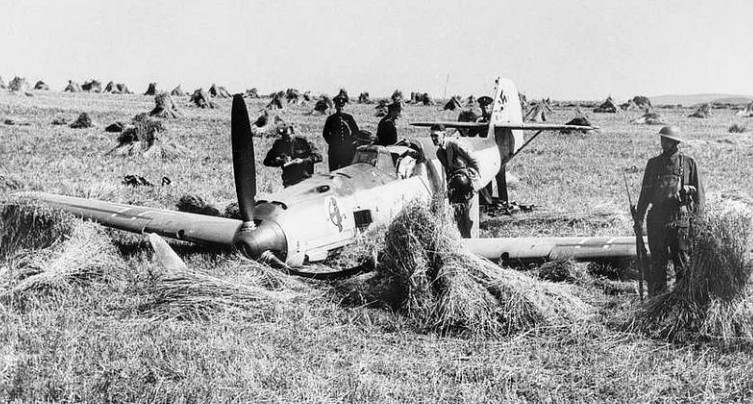
Bf109 E-1 of 2/JG52, shot down on the 12th August,1940. The lack of cannons protruding from the front of the wings shows it to have only machine gun armament. Did a third of the Bf109s used in the Battle of Britain lack cannon armament?
An appraisal of its use in the Battle of Britain.

Bf109 E-1 of 2/JG52, shot down on the 12th August,1940. The lack of cannons protruding from the front of the wings shows it to have only machine gun armament. Did a third of the Bf109s used in the Battle of Britain lack cannon armament?
It has become a recurring meme on YouTube videos and online forums that one of the principal advantages of the Messerschmitt Bf109 in the Battle of Britain was its use of 20mm cannons. The use of two cannons, one in each wing, to supplement the fuselage-mounted rifle-calibre machine guns, being judged superior to the 8 rifle-calibre, wing-mounted machine guns used in RAF Spitfires and Hurricanes. If you try to point out that many of the Bf109s used in the Battle of Britain were the E-1 variant, which had an armament of 4 rifle-calibre machine guns and no cannons, you are usually met with incredulity or accused of lying. Sometimes you are told that the E-1s were "only used for training" or that they "were phased out during the battle", or they were "all updated with cannons in the wings".
How do you resolve this issue and try to find out how much the E-1 variant was used during the Battle? Just finding out how many were listed on unit strengths would not prove they were being used on combat missions. Luckily, we stand on the shoulders of giants. Back in the 1980s, the "After the Battle" team released their meticulously researched book "The Battle of Britain Then and Now". This includes a list, compiled by Peter D Cornwell, of all the Luftwaffe losses, crash-landings and accidents over the period of the Battle (10th July-31st October 1940). This provides details of the incidents, including whether they were combat-related. Happily, for our purposes, it records the variant of Bf109 involved in most cases (drawn from Luftwaffe records). There is a small minority of cases where the variant is not recorded (which I will refer to as "unknown").
How do you resolve this issue and try to find out how much the E-1 variant was used during the Battle? Just finding out how many were listed on unit strengths would not prove they were being used on combat missions. Luckily, we stand on the shoulders of giants. Back in the 1980s, the "After the Battle" team released their meticulously researched book "The Battle of Britain Then and Now". This includes a list, compiled by Peter D Cornwell, of all the Luftwaffe losses, crash-landings and accidents over the period of the Battle (10th July-31st October 1940). This provides details of the incidents, including whether they were combat-related. Happily, for our purposes, it records the variant of Bf109 involved in most cases (drawn from Luftwaffe records). There is a small minority of cases where the variant is not recorded (which I will refer to as "unknown").
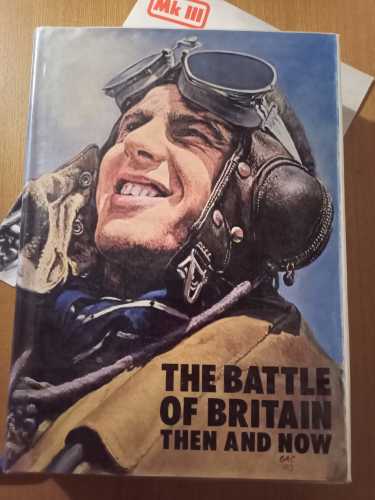
The massive volume of "The Battle of Britain - Then and Now".
I've gone through the listing and extracted the following information. This table lists all losses, crashes and accidents for the various E variants throughout the months of the Battle of Britain (the figures for July start from the 10th). If you are viewing this on a phone or tablet, this would best be viewed in landscape mode.
TABLE OF ALL BF109 VARIANT LOSSES, DAMAGE AND ACCIDENTS, JULY - OCT 1940.
A reminder of the principal differences: The E-1 was the variant built with an all-machine-gun armament. The E-3 was the version built with an MG FF 20mm cannon in each wing. The E-4 had the MG FF/M cannons, which fired a more destructive, thin-walled "mine shell". Some later E-4s used the DB601N engine that gave better high-altitude performance. The E-7 introduced the ability to carry a drop tank to extend range; the DB601N engine was also fitted to many E-7s. The E-7 only became available in numbers towards the end of the battle. The E-8 was the machine-gun-armed E1 modified to carry a drop tank; likewise, it only became available at the end of the battle. A full list of Bf109 types can be found at <this link>.
There is also a single E-2 listed in the book, but I've missed it out of the table. On the 8th August 1940, an E-2 of II/JG27 is listed as returning to base damaged after combat with British fighters. The Bf109 E-2 is a bit of a mystery aircraft, with many sources saying no such variant existed. Others say it did exist, but just how many were built and what exact armament it carried is not known. The most widely shared opinion is that it had cannons in the wings and also a cannon firing through the propeller hub.
What is perhaps surprising from this table is the low number of the E-3 variant shown. Most sources say 1,276 examples of the E-3 were built, while only 561 E-4s are said to have been built on production lines. Yet the E-4 greatly outnumbers the E-3 in the table. This would imply that the majority of E-3s were converted to carry the MGFF/M cannon and became E-4s. The number of E-3s seems to have declined over the course of the Battle. The E-3 seems to have been much more prevalent during the Battle of France (looking at similar information in "The Battle of France - Then and Now" book ).
There is also a single E-2 listed in the book, but I've missed it out of the table. On the 8th August 1940, an E-2 of II/JG27 is listed as returning to base damaged after combat with British fighters. The Bf109 E-2 is a bit of a mystery aircraft, with many sources saying no such variant existed. Others say it did exist, but just how many were built and what exact armament it carried is not known. The most widely shared opinion is that it had cannons in the wings and also a cannon firing through the propeller hub.
What is perhaps surprising from this table is the low number of the E-3 variant shown. Most sources say 1,276 examples of the E-3 were built, while only 561 E-4s are said to have been built on production lines. Yet the E-4 greatly outnumbers the E-3 in the table. This would imply that the majority of E-3s were converted to carry the MGFF/M cannon and became E-4s. The number of E-3s seems to have declined over the course of the Battle. The E-3 seems to have been much more prevalent during the Battle of France (looking at similar information in "The Battle of France - Then and Now" book ).
If we total up the incidents involving the E-1 and the E-8 variants and work it out as a percentage against the known cannon-armed variants (ignoring the "unknowns), we get 38% of incidents relating to the potentially machine-gun-armed variants. If we assume the numbers of losses, damage and accidents reflect the numbers of aircraft in service, then we would conclude that approximately 38% of the Luftwaffe single-seat fighter force was composed of potentially machine-gun-armed variants during the Battle of Britain.
However, that does not necessarily mean that the same percentage of Bf109 E-1s flew in combat. It could be that the E-1s were used for training, communication or "hack" duties. Luckily, "The Battle of Britain - Then and Now" is very good at indicating which aircraft were lost on combat missions. If we take out all the losses, crashes and damage that did not take place during operational missions, we get the following figures...
However, that does not necessarily mean that the same percentage of Bf109 E-1s flew in combat. It could be that the E-1s were used for training, communication or "hack" duties. Luckily, "The Battle of Britain - Then and Now" is very good at indicating which aircraft were lost on combat missions. If we take out all the losses, crashes and damage that did not take place during operational missions, we get the following figures...
TABLE OF ALL BF109 VARIANT LOSSES, DAMAGE AND ACCIDENTS IN COMBAT OPERATIONS, JULY - OCT 1940.
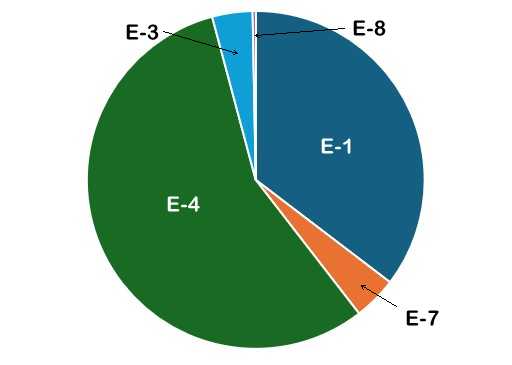
Again, ignoring the "unknowns" which could be any of the different variants, we get a figure of 35% for use of potentially machine-gun-armed variants in combat over the course of the Battle of Britain. If we break it down by month, we get 44% in July, 37% in August, 33% in September and 34% in October. This might indicate a very slight reduction in the use of the E-1 variant throughout the battle, but only slightly. It still indicates a third of the Bf109s used were potentially of the machine-gun-armed variety.
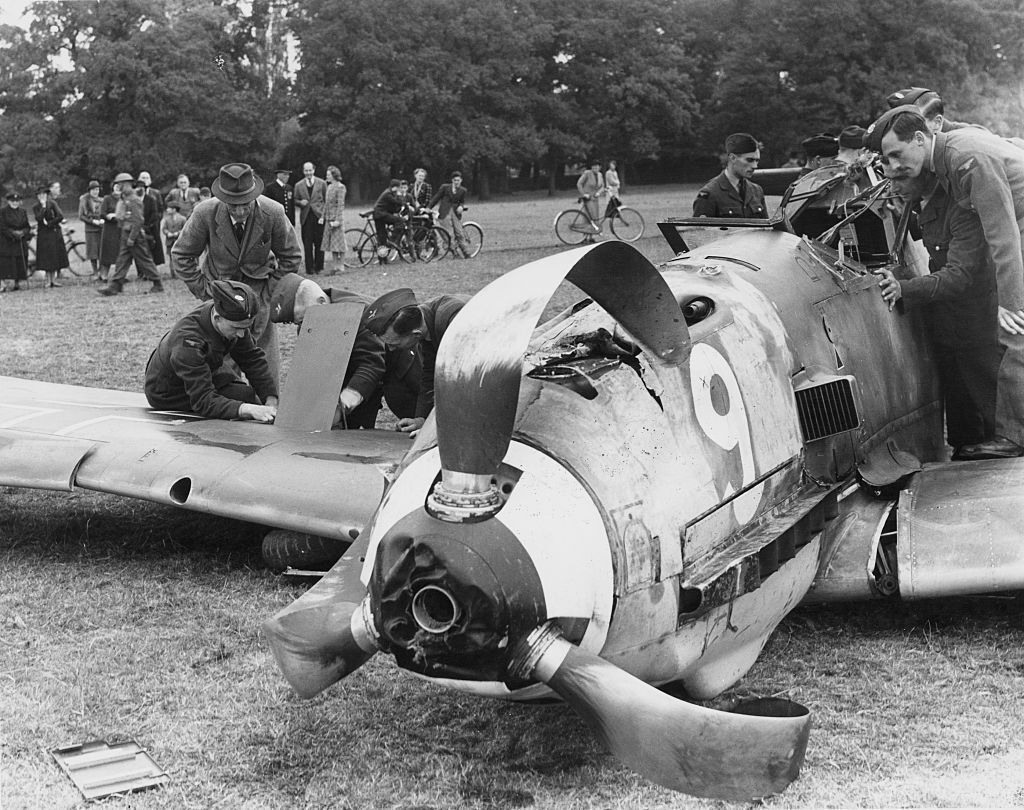
Bf109 E-1 of 7/JG27, crashed in Windsor Great Park on 30th September 1940. It originally landed on its back (hence the damage to the cockpit), but miraculously, the pilot escaped uninjured. The lack of protruding cannons shows it has machine guns in the wings.
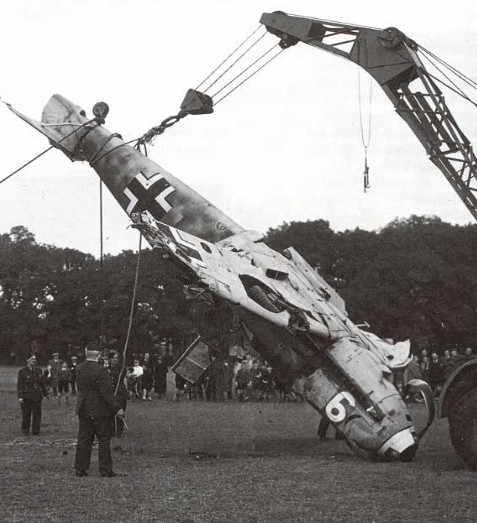
The Windsor Great Park E-1 was widely photographed at the time. This image shows there are no bulges for cannon drums below the wings.
Looking at the record, the use of the E-1 was not confined to specific staffels, gruppen or jagdgeschwader. They seem to have been spread equally over the Luftwaffe fighter force. Only one event sticks out where a lot of E-1s were lost together. That was around 1.15 pm on the 31st August 1940, when five E-1s were shot down and one badly damaged over the Thames Estuary. They were all of JG77, but were spread across three gruppen and an E-4 of the same Jagdgeschwader was shot down at the same time. This all points to the various variants being operated by the same units at the same time. There would be no logistical reason to prevent this while they all used the DB601A engine.
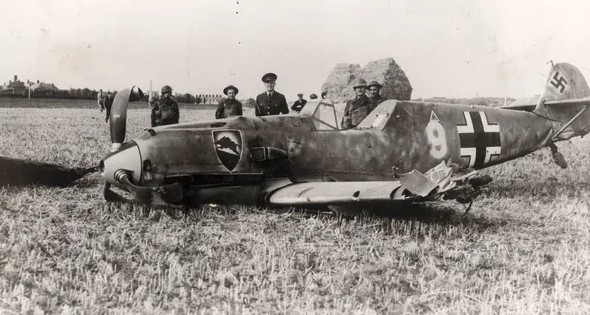
Bf109 E-1 of I/JG52 that crashed landed in Kent on the 24th August 1940 after its engine failed. It had machine guns in the wings, and the curved-top style of canopy.
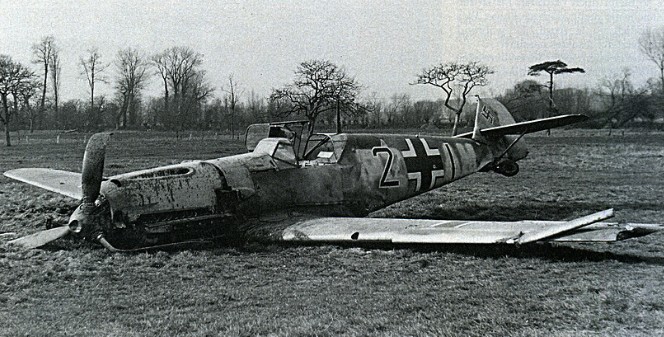
Not a casualty during the Battle of Britain, this Bf109 E-1 belonging to JG3 that crashed in March 1941. It would seem to have machine guns in the wings and the curved-top style of canopy.
So the last argument remaining is that perhaps the E-1s were converted to carry cannons in the wings in place of the machine guns. Why would the Luftwaffe go on reporting the aircraft as E-1s in records if they were now converted to E-4 standard? It seems that E-3s were redesignated as E-4s with much less structural change than would be required for an E-1 to be converted. Why would the Luftwaffe go to the trouble of converting E-1s to E-4 standard while there were more easily converted E-3s still flying in combat? Most compellingly, where photographs of crashed Bf109s exist that are listed as E-1s in the book, examination of the photos does indeed show them to have only machine gun armament, with no protruding cannon barrels or bulge under the wing to accommodate the cannon drum magazine. However, there is one single aircraft that I can find that would seem to contradict all this. On the 13th August 1940, what is identified in "Battle of Britain - Then and Now" as a Bf109 E-1 of 1/JG2, crash landed in a field next to Shoreham aerodrome. Photos of the aircraft clearly show it to have cannons protruding from the wings and a bulge under the wings consistent with a cannon ammunition drum. Is this an E-3 or E-4 misidentified as an E-1? It has the flat-topped canopy introduced on the E-4. Or is it really the case that some E-1s were fitted with cannons and the new style of canopy and continued being called E-1s by the Luftwaffe? It seems unlikely. Some sources say the Shoreham Bf109 had the "werknummer" 5068 which does not make it an E-1 at all, rather one of a batch of 249 E-3s built by the Weiner Neustadter Flugzeugwerke (WNF) in Austria.
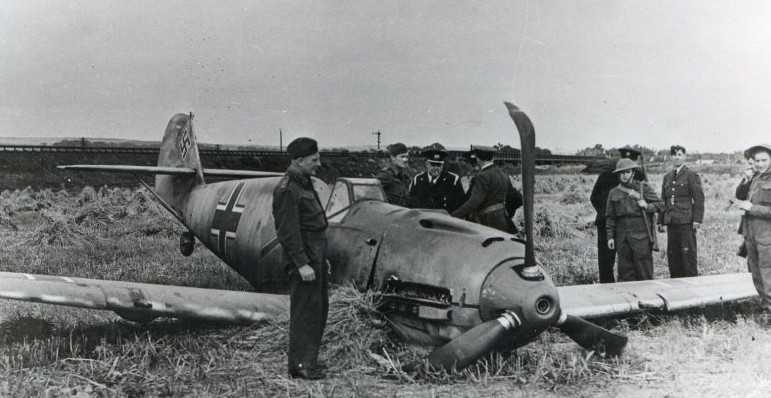
The Bf109 that force-landed next to Shoreham aerodrome on the 13th August 1940. Identified in records as an E-1, it clearly has cannons in the wings. It also has the flat-top style canopy with slab sides to the front windscreen introduced on the E-4 but which was retrofittted to earlier E-3s and E-1s. If the Weknummer associated with it (5068) is true, it is not an E-1 at all, but was built as an E-3.
I'm not saying that no E-1s were ever converted to E-3 or E-4 status. I just think it is unlikely that the Luftwaffe would continue to refer to such conversions "E-1s". The issue of identifying any such conversion is complicated by the fact that the wings were designed to be able to carry either a machine gun or a cannon. The wing cannon installation on a Bf109 E was a little bit outboard of where the machine gun would be fitted. On Bf109 E wings equipped with cannons, there is a "plug" in the wing leading edge, inboard of the cannon, where a machine gun could be fitted to replace the cannon. On some crashed Bf109s, this "plug" has become detached, giving the impression that the aircraft carried both cannons and machine guns in the wings. Photos of these are usually labelled as E-1s that have converted to E-3 or E-4 standard. The MG 17 machine guns in the wings of the E-1 had a complicated ammunition feed system that ran the whole length of the wing, over a roller, and back again. This feed system had to not only hold the full ammunition belt, but also store the empty ammunition belt after it had been used (the MG 17 used a flexible metal ammunition belt that remained intact after the ammunition was used, unlike the disintegrating belts used by Spitfires and Hurricanes). That ammunition feed system would presumably need to be stripped out of any E-1 wing converted to use cannons. In any event, the Bf109 was notable for the ease with which the wings could be taken off and replaced. So it's not unreasonable to assume that some fuselages that started out as E-1s may have had "cannon" wings fitted to bring them up to E-3 or E-4 standard.
So, there seems to be no conclusive way of saying that all the E-1s flown in the Battle of Britain retained machine-gun armament. All we can say is that the photographic record would suggest is that the majority of them did. What we can say for certain is that the E-1 variant, in whatever form, played a crucial role in the Battle.
One point about the Bf109 E-1 needs stressing before anyone dismisses it as having less firepower than a Spitfire or Hurricane. It depends on how you measure firepower. Although they only had four machine guns compared to the Spitfire and Hurricane's eight, the Bf109 E-1 carried slightly more ammunition. The British had 350 rounds per gun, 2,800 rounds in total, while the Bf109 E-1 had 1,000 rounds for each fuselage gun and 500 rounds for each wing gun, a total of 3,000 rounds. Thus, an E-1 pilot could keep his finger on the trigger for three times longer than a Spitfire and Hurricane pilot, and deliver just as much weight of fire if he could keep on target that long. A further discourse on this "Duration of Fire" issue can be found at <this link>.
One point about the Bf109 E-1 needs stressing before anyone dismisses it as having less firepower than a Spitfire or Hurricane. It depends on how you measure firepower. Although they only had four machine guns compared to the Spitfire and Hurricane's eight, the Bf109 E-1 carried slightly more ammunition. The British had 350 rounds per gun, 2,800 rounds in total, while the Bf109 E-1 had 1,000 rounds for each fuselage gun and 500 rounds for each wing gun, a total of 3,000 rounds. Thus, an E-1 pilot could keep his finger on the trigger for three times longer than a Spitfire and Hurricane pilot, and deliver just as much weight of fire if he could keep on target that long. A further discourse on this "Duration of Fire" issue can be found at <this link>.
A rundown of Bf109 armament development can be found at <this link>.
More photos and details of the Shoreham Bf109 are on the Aircrew Rememberance Society website at <this link>.
My thanks to Joe Sangeto for launching me down this rabbit hole!
This article was first written in August 2025. I reserve the right to alter it if I am aware of more information on the subject. It was not part of my original floppy disk "hyperbook" on the Bf109, first issued back in the early 90s.
